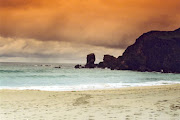I should have mentioned that on the train journey north,quite a few people alighted at Glenfinnan Station,on their forward journey to Ardnamurchan ,to villages like Acharchle,Kilchoan and Strontian. Acharchle,means "the field of Haakon",where the Vikings were engaged in a large battle. Strontian gave its name to the chemical element strontium,first isolated in an ore found there. It was a beautiful sight to see the steamer down on Loch Shiel,tied up to the pier at the head of the loch. It awaited the passengers off the train. The romantics will know that it was at Glenfinnan that Charles Edward Stuart raised the Jacobite standard in the ill-fated rebellion of 1745-46. The voyage on the Loch Nevis was the last leg of a long,exhausting journey that began at 5.00 am and would end around 10.00 pm that same day - like a day's journey with the Israelites of yore. A good hour or more out of Kyle of Lochalsh,you would hear the ship's engines coming to a halt. Looking down over the starboard side of the ship,you would see a large boat manned by 4 to 6 strong men on the oars pulling alongside a hatch on our ship's side. This was the boat to meet passengers and cargo bound for Applecross(usually no more than 3/4 people and some goods from Glasgow). When I was young,the minister of the Gaelic Church in Partick,Glasgow was the Reverend Kenneth Gillies,a fine gentleman,and he was from Applecross. He officiated at my parents'wedding and at mine. I always wanted to visit Applecross,and this year I managed it, over that crazy zig-zag road which must be an old drove road. The crest is called "Bealach na Bo"( the pass of the cows). This was an unforgetable journey to an area of outstanding beauty. How the English sounding name Applecross came about,I've always found strange,when its proper name,in Gaelic of course,is "Am Chomraich" which means "sanctuary", altogether more apt than that other curious appelation,Applecross.
A few miles out from Stornoway,the poor people in the saloon would have heard that their travails were nearly over,and began to ready themselves and their children for disembarkation. Those on deck,even this far out,would smell the wonderful "reek" of the peat fires of the town,because in the late 1940s,even the "townies" had their peat cuttings on the bogs outside Stornoway. Sailing into Stornoway harbour,our excitement was palpable. We were "home",or very nearly so. The dockers helping us down the gangway all spoke to us in Gaelic, and appeared to me at any rate, as tall, strong and very weather beaten(but certainly not tanned). They all looked like elders of the Free Church,and probably were. Carrying our luggage and ourselves onto South Beach Street,we would be confronted with more buses than one would normally see in Lewis standing side by side, each with a different destination,but each spelling "home" for some of those from the "steamer". The names of the destinations on the front of each bus had a magic ring to them - Lemreway,Ness,Bernera,Lochs,Portnaguran,Harris,Uig and on and on. We quickly found our bus,the one for Carloway via Barvas and Shawbost and points west. As usual,our driver was "The Magaran",who had been through Carloway school in the same class as my mother. Contacts are important,even in Carloway,and a couple of half-crowns can, even here, make a hell of a difference.
Dalmore Daytime

Sandy Beach
Friday, 29 February 2008
Subscribe to:
Post Comments (Atom)


1 comment:
Wonderfully evocative stuff. I have come "home" to Lewis by boat from Ullapool, plane from Inverness and Glasgow and car via Skye and Harris and it's always special. And that first whiff of the Peat Reek...
Post a Comment